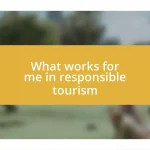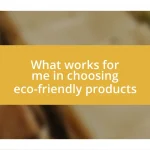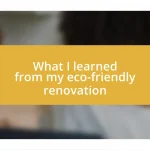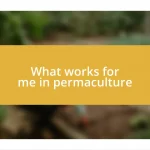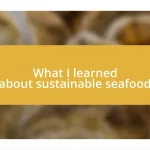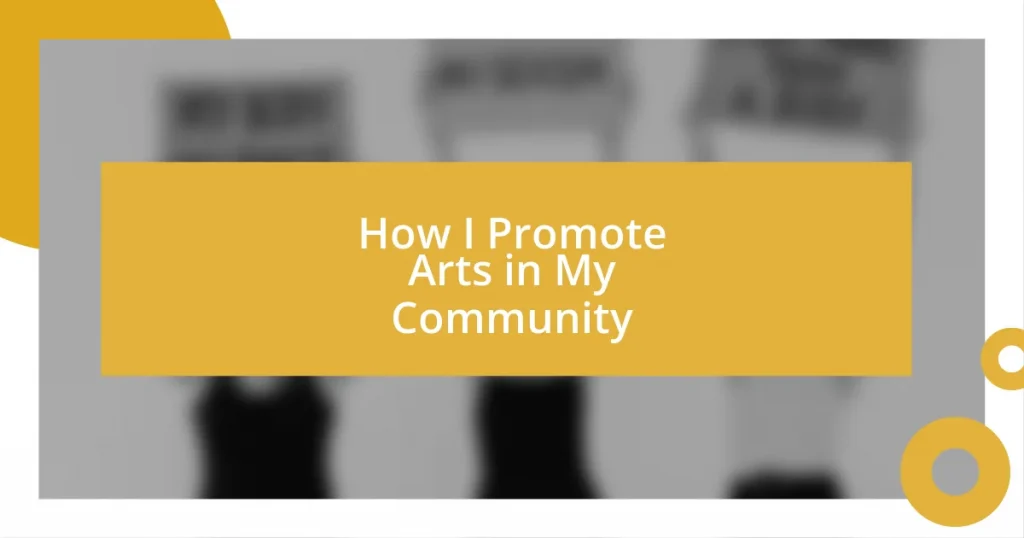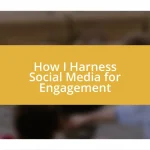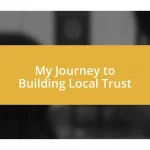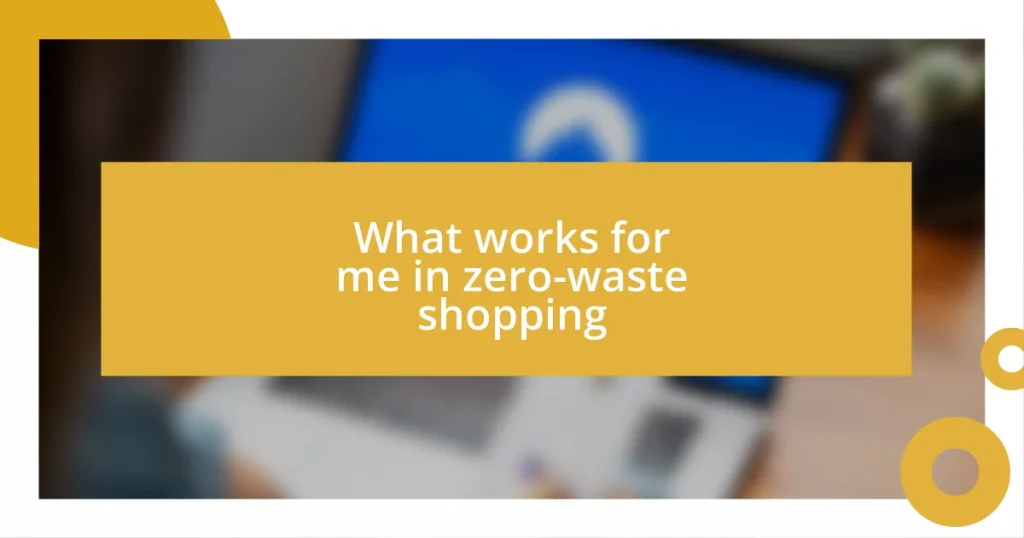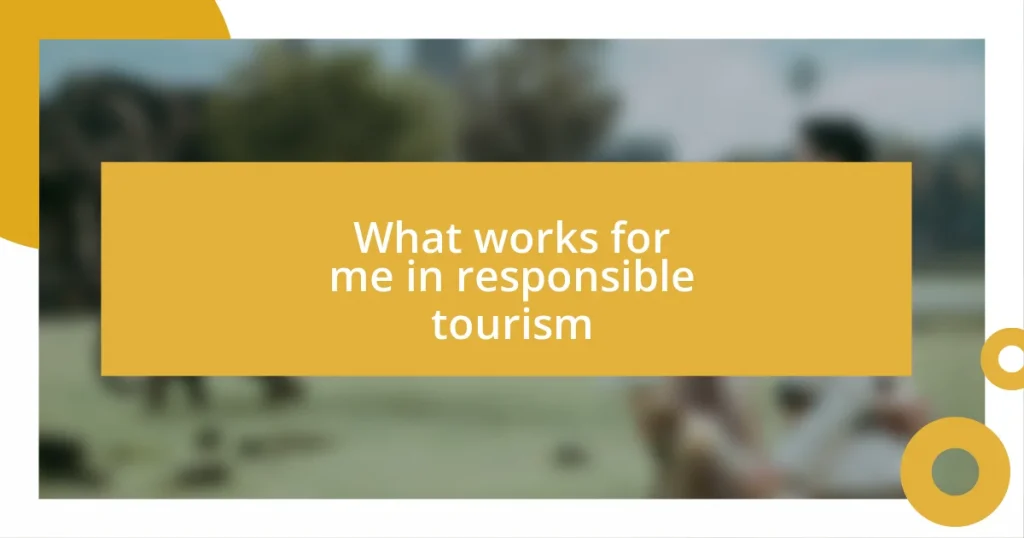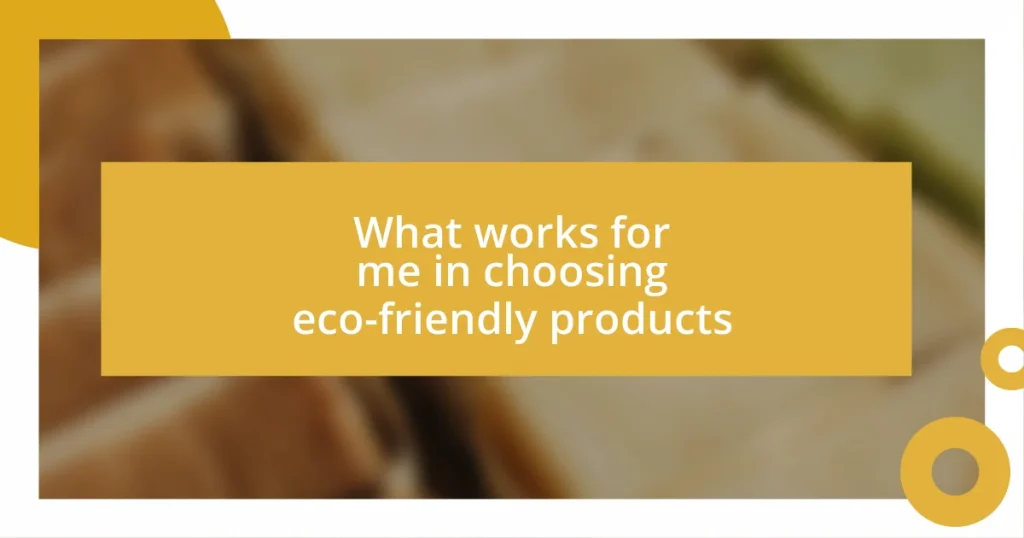Key takeaways:
- Engaging with the community through direct conversations reveals unique artistic needs and desires, fostering inclusivity and connection.
- Collaborating with local schools and organizations enhances creative expression, builds pride among students, and bridges the gap between academia and community involvement.
- Utilizing social media effectively promotes local art initiatives, encourages community dialogue, and helps measure impact through feedback and engagement metrics.

Understanding Community Art Needs
Understanding the art needs of a community requires more than just looking at statistics; it demands genuine conversations with local residents. When I held a pop-up art booth in my neighborhood park, I was amazed by the variety of responses I received. One elderly gentleman shared how painting had been a refuge for him during tough times, asking, “Why aren’t there more places to create art together?” His question stuck with me, showcasing not only a need for artistic spaces but also a longing for connection.
Every community is different, often with unspoken expectations and unique aspirations regarding the arts. I remember speaking with a group of teens who expressed frustration over a lack of avenues for self-expression. They craved not just an outlet for their creativity but also feedback and mentorship. Reflecting on their passion and eagerness, I felt a surge of responsibility to advocate for programs that provide them the guidance they seek.
Moreover, understanding these art needs goes beyond individual desires; it feeds into the broader cultural fabric of the community. During a local festival, I noticed a remarkable absence of representation from various cultural backgrounds in the art exhibits. This gap highlighted a crucial point: Are we truly reflecting the diverse voices of our community? Recognizing these needs isn’t just about gathering preferences; it’s about weaving inclusivity into the heart of our local arts scene.

Identifying Local Artists and Organizations
Identifying local artists and organizations is like unearthing hidden gems in a well-loved neighborhood. In my journey, I found that connecting with local art groups often starts at unexpected places. For instance, while volunteering at a community center, I struck up a conversation with a talented muralist who mentioned not only his artistic journey but also the struggles he faced in gaining visibility. This encounter ignited my curiosity about the wealth of creativity right under our noses.
To successfully identify local talent and organizations, I’ve developed a few practical approaches that work wonders:
- Attend local art fairs, markets, and exhibitions to meet artists and see their work firsthand.
- Engage with social media platforms where local creativity is showcased, like Facebook groups or Instagram hashtags dedicated to community art.
- Build relationships with schools and universities offering art programs, as students and instructors often have great insights and talents.
- Collaborate with local businesses that feature community art, uncovering both established and emerging artists.
- Organize casual meetups or forums to invite artists and art lovers to share their stories and challenges openly.
Through these efforts, I felt a genuine sense of community blossom—each conversation painting a fuller picture of the creative landscape around me.
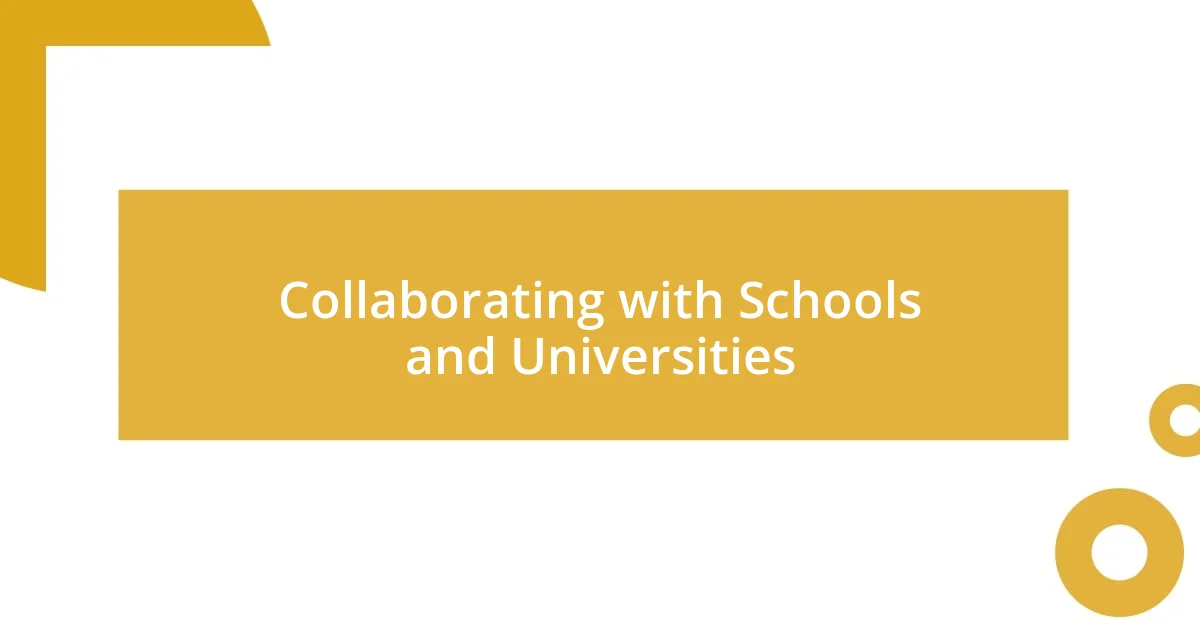
Collaborating with Schools and Universities
Collaborating with schools and universities can be transformative for community art initiatives. I vividly recall partnering with a local university’s art department for a community mural project. What struck me the most was the enthusiasm of the students—they approached each brushstroke with an infectious energy that inspired everyone around them. This collaboration not only beautified a neglected wall but also fostered connections between students and residents, bridging the gap between academia and everyday life.
When I facilitated workshops in schools, I was genuinely fascinated by the creativity bubbling beneath the surface of each classroom. One young student painted a vibrant canvas depicting their blended family, which opened up conversations about identity and connection. These experiences reinforced my belief in the power of art as a tool for dialogue, especially among young people who are still discovering their voices. Engaging with academic institutions creates opportunities for mentorship and growth, enriching the artistic landscape of the community.
Additionally, I’ve discovered that involving schools and universities in community art projects cultivates a sense of ownership among students. I recall coordinating an art exhibit where students showcased their work alongside established artists. The pride on their faces when they saw their art displayed was unmatchable. It’s this sense of pride and responsibility that not only energizes young artists but also encourages long-lasting commitments to nurturing local art culture.
| Collaboration Benefits | Examples |
|---|---|
| Fosters Relationships | Community mural projects |
| Encourages Creative Expression | Workshops in schools |
| Builds Sense of Ownership | Student art exhibits |

Organizing Community Art Events
Organizing community art events can be truly rewarding, yet it requires vision and coordination. I remember one time when I hosted a local art fair in a neighborhood park. The excitement was palpable, especially as families began to gather, each person discovering a unique facet of creativity. Seeing a child’s eyes light up while painting a canvas or an elderly neighbor connecting over a shared appreciation for art is something I will never forget.
In my experience, logistics play a key role in the success of these events. Personally, I learned the importance of securing permits and promoting the event well in advance. I once underestimated the power of social media marketing—after posting weekly updates about an upcoming art show, attendees multiplied, leading to unexpected connections among artists and art enthusiasts. It’s fascinating how just a little excitement can build momentum and create a lively atmosphere that draws people in.
Moreover, fostering community involvement is paramount. I often invite local artists to not only showcase their work but also to conduct interactive workshops. During one event, a local sculptor guided attendees in creating their own pieces. The laughter and camaraderie that filled the air reminded me of art’s unique power to unite people. Isn’t it incredible how art can turn strangers into friends and a casual event into a memorable experience?

Utilizing Social Media for Promotion
In my experience, social media has transformed the way I promote arts in my community. I started by creating a dedicated Instagram page for local artists to share their work and upcoming events. The initial response was overwhelming. I remember the thrill of seeing an artist tag me in their post, showcasing their latest piece, and feeling the excitement of our community’s talent shine through. It’s like having a digital gallery right at our fingertips!
Harnessing the power of platforms like Facebook has also proven invaluable. I initiated a Facebook event for a collaborative art project, and to my surprise, it organically attracted an audience far beyond my expectations. With just a few shares from friends, our local art initiative reached numerous art lovers who were eager to join in. I often wonder, how can we further use these digital platforms to not only share art but also create a sense of belonging?
Moreover, I discovered that engaging the community through social media challenges has fostered a vibrant artistic dialogue. I once launched a “30-day art challenge,” encouraging participants to share their creations daily. The creativity that emerged was astounding! Witnessing someone post their process, along with their challenges and triumphs, reminded me that art is as much about the journey as it is about the final product. It’s fulfilling to know that social media can serve as a space for shared experiences and collective growth in the art community.

Seeking Sponsorships and Partnerships
When it comes to seeking sponsorships and partnerships, I’ve found that building genuine relationships is essential. I recall a moment when I approached a local coffee shop owner about showcasing a mural in their space. After some conversations over cups of their finest brew, I learned that they too were passionate about supporting local artists. I was thrilled—not only did they provide a platform for an artist’s work, but they also hosted a launch event that brought in their regulars, sparking conversations about art and community connection.
In my opinion, it’s crucial to align on shared values with potential sponsors. I once collaborated with a bookstore that had a strong emphasis on community engagement. Together, we organized a poetry reading event, where local poets could share their work. The bookstore saw increased foot traffic, and the poets received exposure, which was a win-win situation. Isn’t it fascinating how aligning interests can create opportunities that resonate with everyone involved?
Networking isn’t just about exchanging business cards—it’s about fostering a sense of trust and mutual benefit. I remember attending a local business networking event, where I introduced myself to a gallery owner who was looking for community collaboration. Our conversation turned into brainstorming sessions, and before I knew it, we had organized an artist showcase. The excitement that ensued from that partnership reminded me that creativity thrives on collaboration. What can be more powerful than uniting different passions to elevate our artistic community?
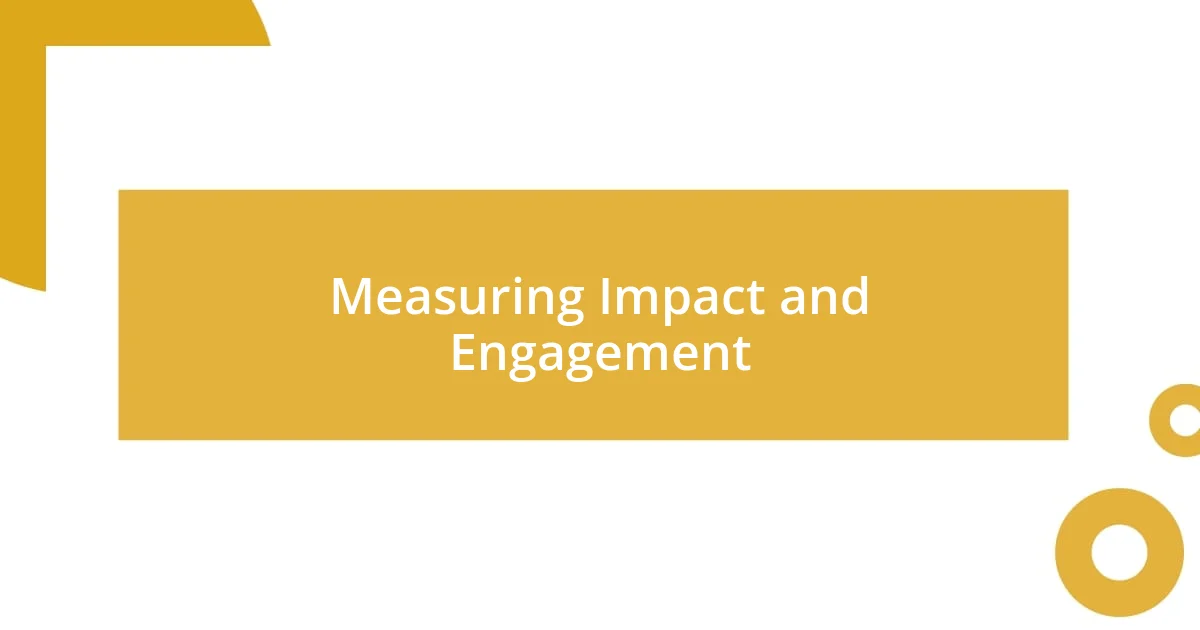
Measuring Impact and Engagement
To effectively measure the impact and engagement of my arts initiatives, I’ve found it helpful to gather qualitative and quantitative feedback. For example, during a mural project, I placed a simple feedback box nearby, inviting local passersby to share their thoughts and feelings about the artwork. I was pleasantly surprised when the responses poured in, with many expressing a deeper appreciation for public art. This kind of direct engagement not only informs me about the community’s perspective but also strengthens their connection to the space.
In terms of numbers, I like to track attendance at events and participation in workshops. After hosting an open studio day, I calculated the increase in foot traffic through the venue’s social media engagement compared to previous months. The joy I felt when seeing those numbers rise was unforgettable! It became clear that creative programming directly correlates with audience curiosity and interest. I sometimes wonder, what if we could do even more to bridge these experiences digitally?
I’ve also turned to surveys and social media insights as tools to reflect on our artistic endeavors. After a recent community art festival, I sent out an online survey asking attendees about their experiences—what they loved, what resonated with them, and what could be improved. The candid responses opened my eyes to the power of community input. Engaging in this dialogue not only helps me grow as a promoter of the arts but also fosters a sense of ownership among community members. Isn’t it fulfilling to think that our shared experiences can shape future artistic endeavors?

